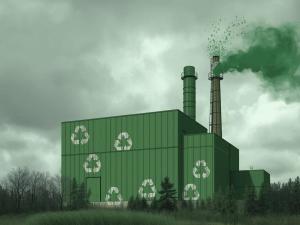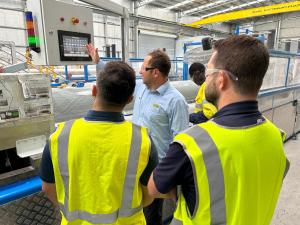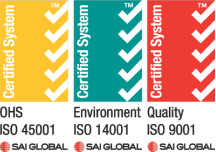a blog by Wagners CFT NSW Business Development Manager, Matt Hammond (Connect via LinkedIn)
In recent years, environmental sustainability has become a central concern for engineers, project managers, and procurement teams across infrastructure sectors. With increasing scrutiny on carbon footprints, resource use, and long-term environmental impacts, suppliers of building materials are under pressure to demonstrate their green credentials. Fibre Reinforced Polymer (FRP) products, widely used in utility poles, boardwalks, pedestrian bridges, and other infrastructure, are no exception.
Unfortunately, not all FRP manufacturers approach sustainability with transparency. Some companies make broad “eco-friendly” or “low carbon” claims without providing verifiable evidence to substantiate their statements. This can mislead purchasers, resulting in projects that are less sustainable than advertised and exposing asset owners to reputational risk.
Understanding the difference between marketing claims and verified environmental performance is critical for informed decision-making.

Not all FRP manufacturers approach sustainability with transparency; Some make broad ‘eco-friendly’ or ‘low carbon’ claims without providing verifiable evidence.
The Problem with Greenwashing in FRP
Greenwashing occurs when a company presents a product or practice as more environmentally friendly than it truly is. In the FRP industry, this can take several forms:
- Claiming that a product is “sustainable” simply because it is made from synthetic fibers rather than timber, without accounting for the energy and materials used in production.
- Suggesting that FRP is “carbon neutral” without supporting data from a recognized standard.
- Using vague terms like “eco-responsible” or “environmentally friendly” in marketing materials, while avoiding disclosure of lifecycle impacts.
These claims may sound attractive, especially to environmentally conscious clients, but without independent verification, they are effectively greenwashing. Asett owners relying solely on these statements risk making decisions based on incomplete or misleading information.
Why Verification Matters
Transparent, scientifically grounded environmental data allows consumers to evaluate the true impact of FRP products. This is where tools like Life Cycle Assessments (LCAs) and Environmental Product Declarations (EPDs) become invaluable.
- Life Cycle Assessment (LCA): An LCA evaluates the environmental impact of a product throughout its life—from raw material extraction to production, transportation, use, and end-of-life disposal. For FRP products, this includes energy consumption in pultrusion, emissions from resin manufacturing, and the impacts of transportation and installation. An LCA provides a detailed, evidence-based foundation for environmental claims.
- Environmental Product Declaration (EPD): An EPD is a standardized, third-party verified document that presents the results of an LCA in a transparent, internationally recognized format. It follows strict ISO standards (ISO 14025 and EN 15804) and provides objective data on carbon footprint, energy use, and other environmental indicators. Importantly, an EPD allows buyers to make meaningful comparisons between different products and suppliers.
In short, while marketing claims are easy to make, an EPD is difficult to dispute as it represents rigorous scientific assessment rather than promotional language.

Transparent, scientifically grounded environmental data allows consumers to evaluate the true impact of FRP products.
Wagners CFT: Setting the Benchmark for Transparency
Australian FRP manufacturer Wagners Composite Fibre Technologies (CFT) exemplifies best practice in this space. Wagners CFT has an Environmental Product Declaration that is third-party verified and internationally recognized. This means that all claims about the environmental performance of their pultruded FRP profiles are based on independently reviewed data, not marketing spin.
For purchasers, this provides peace of mind. It ensures that the low environmental impact of Wagners FRP products is not just a slogan, but a verified reality. Using Wagners’ EPD, engineers and project managers can accurately calculate embodied carbon for infrastructure projects, support green building certifications, and make responsible procurement choices.
Key Questions to Ask FRP Suppliers
To avoid greenwashing and make informed decisions, customers should ask FRP businesses specific, evidence-based questions:
- Do you have an Environmental Product Declaration (EPD)?
- If yes, request a copy. Ensure it is independently verified and complies with ISO 14025 and EN 15804 standards.
- If no, be cautious—without an EPD, it is difficult to validate any environmental claims.
- Have you conducted a Life Cycle Assessment (LCA)?
- Ask whether it covers all stages of the product lifecycle, including raw material extraction, manufacturing, transport, installation, use, and end-of-life disposal.
- Check whether it has been peer-reviewed or conducted according to ISO 14040/14044 standards.
- What are the key environmental indicators of your product?
- These may include global warming potential (GWP), embodied energy, water consumption, and waste generation.
- Ask for data expressed in measurable units, not just qualitative statements.
- Are your claims independently verified?
- Marketing statements are insufficient. Independent verification ensures credibility and removes bias.
- How do your products compare to industry alternatives?
- A transparent supplier will be able to contextualize their environmental impact relative to timber, steel, or concrete alternatives.
- Do you provide supporting documentation for end-of-life scenarios?
- FRP durability is a key benefit, but what happens at the end of the product’s life? Responsible suppliers will provide guidance on recycling, reuse, or safe disposal.

To avoid greenwashing and make informed decisions, customers should ask FRP businesses specific, evidence-based questions about their products.
Why Buyers Should Insist on Evidence
In Australia and globally, governments, clients, and certification schemes increasingly require environmental transparency. Green building certifications, sustainable procurement policies, and public infrastructure standards often mandate verifiable data rather than marketing claims.
By insisting on EPDs, LCAs, and third-party verification, buyers can:
- Minimize environmental risk and reputational exposure.
- Ensure that sustainability goals are genuinely met.
- Make accurate comparisons between suppliers and materials.
- Promote best practice in the FRP industry, encouraging other suppliers to follow suit.
Conclusion
The FRP industry offers remarkable opportunities to reduce the environmental footprint of infrastructure projects. However, buyers must navigate a marketplace where greenwashing is a real concern. Broad environmental claims without evidence are increasingly insufficient—and potentially risky.
Australian manufacturer Wagners CFT demonstrates how transparency and scientific rigor can lead the way. Their independently verified Environmental Product Declaration provides purchasers with a trustworthy, internationally recognized benchmark.
When engaging FRP suppliers, remember: marketing slogans are easy, evidence is hard. Ask the right questions, demand independent verification, and make sustainability decisions based on facts, not hype. By doing so, engineers, project managers, and procurement teams can ensure that their projects are truly environmentally responsible—and that the FRP products they specify live up to their green claims.
Key Takeaways for FRP Buyers:
- Don’t accept vague environmental claims—look for data.
- Request an EPD and ensure it is third-party verified.
- Ask about Life Cycle Assessments for comprehensive environmental insights.
- Examine measurable indicators like carbon footprint, energy consumption, and recyclability.
- Compare products transparently and insist on documentation to support claims.
Sustainability in infrastructure is too important to trust marketing alone. Verified environmental data, like Wagners CFT’s EPD, empowers buyers to make decisions that are responsible, transparent, and truly sustainable.
Join Product Engineer Parminder Singh Jaj as he explores Wagners CFT’s Environmental Product Declaration via this on demand webinar https://www.wagnerscft.com.au/webinars/reduce-embodied-carbon-in-construction/ or read the article https://www.wagnerscft.com.au/wagners-epd-set-to-help-decarbonise-construction/
To download your copy of Wagnes CFT’s EPD visit – https://www.wagnerscft.com.au/app/uploads/2024/05/sp10246-wagners-epd-pultruded-gfrp_nov23-1.pdf
To request a Deep Dive and discuss calculating carbon savings on your next project by choosing Wagners FRP over traditional materials – https://www.wagnerscft.com.au/contact-deep-dive/

Wagners CFT’s Environmental Product Declaration provides credible information about our products that is independently verified and internationally recognised.


